Share
The growth of TikTok and Instagram's Reels feature has made consumers eager to share videos about themselves, their lifestyles, and even the products they buy. Thus, the growth of user-generated videos!
With UGC videos, online brands have the chance to amplify customers’ voices and their experiences with their products to successfully increase brand trust and conversions.
As an eCommerce brand, if you aren’t taking advantage of user-generated videos for your marketing strategy, you’re missing out!
In this extensive guide, we’ll help you understand what UGC videos are and where to find them. You can pick up tips on how to organically get consumers to share user-generated videos and best practices to engage and convert better through UGC.
Let’s get started!
What is User-Generated Video Content?
User-generated video content is any video content created by consumers about a brand rather than by the brand or a commissioned creator. Unlike videos made by brands or for paid campaigns, user-generated content videos are created with everyday equipment like a smartphone.
Ava Estell, an all-natural wellness brand and one of Videowise's customers, uses UGC videos in a shoppable format on their store to build trust and increase their conversion rate. Using UGC videos in the form of shoppable videos has helped them 4x their on-site engagement and increase their conversion rate by 21%.
Let's dive deeper into Ava Estell's and other eCommerce brands' stories that are using UGC videos.
10 UGC video examples and what makes them effective
Here are the 10 D2C brands using UGC videos in their eCommerce marketing strategy:
1. Ava Estell - Explaining how-to on the product page
When he noticed a massive gap in Black representation within the cosmetics industry, Yaw Okyere wanted to change that. Ava Estell is an all-natural skincare brand made for darker skin tones and focused on tackling skin concerns like hyperpigmentation. With a massive following of 299K on Instagram, the brand is loved across the globe.
When browsing your online store, it's always best to clearly explain and elaborate to your shoppers than leave them with unanswered questions. Ava Estell has a “How to Use” section on their product page where shoppers can watch a video to understand how they can get started with their product.
Why it works:
With a “how to use” video, the brand can remove any doubts from their potential shoppers’ minds. The video lets them answer common questions they may have on how and where to use the product. With this clarity, shoppers can confidently make a decision to buy.
In fact, by adding videos on-site, shoppers spent more time on the website. With 4.4K hours added on-site and more than 299K videos watched, Ava Estell was able to generate an additional £743K in revenue at an average conversion rate of 7%. Learn how the skincare brand leveraged video.
2. Dieux Skin - Customers share the positive effects of the product
Dieux Skin is a skincare brand born from a need for transparency in results, price, and science. The team genuinely believes in setting a standard for skincare products, and it shows! The brand has a loyal following, with its products selling out within just hours of launch and rave reviews from the likes of Forbes.
Since they are all about honesty, the brand shares how customers experience their products. Customers don't just share the results but also how they used the product, their unfiltered opinion, and how it made them feel.
Why it works:
There are a few reasons why user-generated content is effective in convincing new shoppers to try the brand:
-
Problem relatability: The customer talks about what problems they had, allowing viewers to identify issues they relate to.
-
Honesty: There’s no exaggeration of the product’s role in the results.
-
Directly from the customer: It’s apparent by the voiceover and the front-facing selfie mode that the customer made the video eagerly.
-
Shows results: The video includes a before and after, showing proof of any results that the customer saw the product usage.
3. Vinterior - How the product adds to the customer's life
Vinterior is an online marketplace that allows anyone to sell and shop unique vintage pieces on a mission to encourage sustainable shopping and an appreciation for characterful furniture. Thanks to the latest boom in acquiring pre-loved and vintage furniture pieces, the brand is now a market leader in the UK, with more than 2K+ sellers globally.
Since each item sold on the website is unique, the brand can't promote individual items. Instead, Vinterior posts about the lifestyle of collecting gorgeous furniture pieces. They reshare customers' videos of how they placed a vintage piece within their living space or how they repurposed a piece of furniture to liven up their home.
Why it works:
Such videos help the brand share a common interest in home decor among its audience. Their videos on social media platforms are a curation of the best home decor and furniture renovation. Thanks to this, new audiences can also pick up inspiration on how to set up their own living space, making the brand’s page a go-to for their audience.
Pro-tip: Don’t just look for UGC content that talks directly about your product. See how you can reshare content that adds value to your audience, like tutorials, inspiration, hacks, etc.
For instance, if you’re a skincare brand, you could reshare videos made by creators about their skincare routines featuring one of your products.
4. Pillow Cube - Increasing social proof with TikTok videos from real customers
Pillow Cube is made for side sleepers, the first of its kind. The brand has gotten rave reviews from top publications like Wirecutter for creating a product that helps customers sleep better and get better neck and spinal support.
With rave reviews and proven results comes a high price tag that may make customers a little reluctant to buy. But Pillow Cube knows just how to tackle that. Website visitors are fully informed about the benefits, features, and even the way the product looks at every touchpoint on the eCommerce store, from the homepage to the product page.
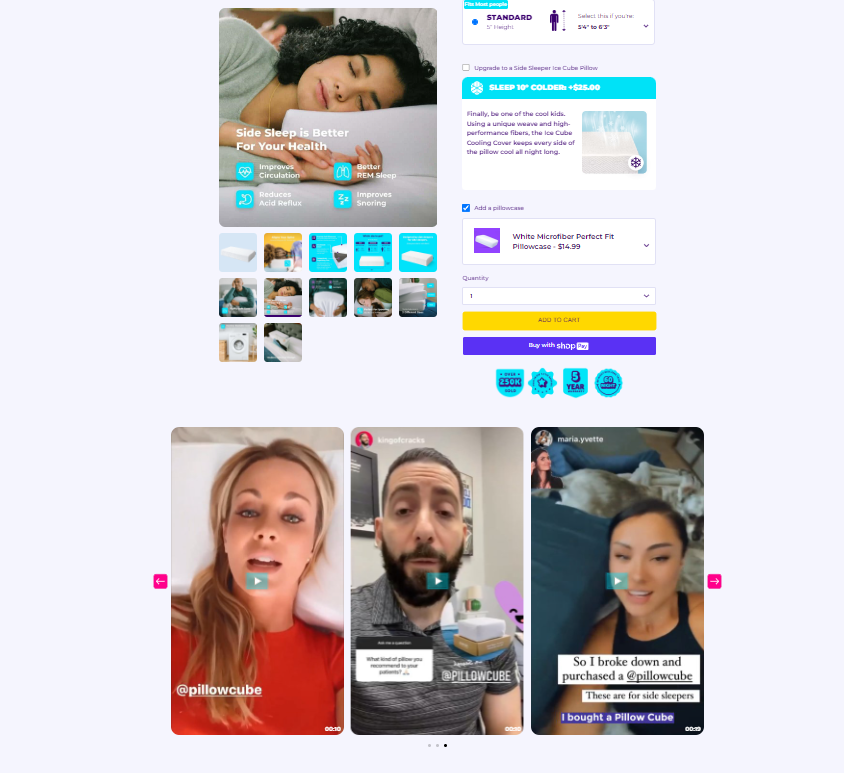
Why it works:
In the interest of educating its website visitors, Pillow Cube has also added a carousel of testimonials taken directly from social media platforms. These testimonials are from different kinds of customers talking about different aspects of the product— how it works, why it’s good for sleep, etc.
Pro-tip: In this day, customers have started to share their experiences of products on social media. So, if your products are made well, customers are sure to rave about them! Once you’ve received a rating from customers on-site, you can get in touch with that customer via email or SMS, asking them to share their thoughts online.
5. Pact - Customers show how they wear it
Launched in an attempt to make the fashion industry more sustainable, Pact is an organic cotton fashion brand that sells clothing that is well-designed, stylish, and ethically made.
Shoppers online have tons of options when it comes to clothing brands. That's why fashion brands need to stand out when marketing themselves. Pact does this with videos and posts that shoppers are eager to watch and save.
Why it works:
For fashion brands, hauls and styling videos are a hit. Styling videos, specifically, allow shoppers to visualize clothing since it’s worn by a real person (rather than a model) as well as the different ways they can wear one item.
With more people on social media creating videos that show how they style their looks, it's easier for fashion brands now to find and reshare user-generated video content that features their clothing.
6. Sama Tea - How the product is part of their daily routine
Sama Tea is made to provide balance in your body, mind, and heart. The brand follows the learnings of Ayurveda, using adaptogenic plants within their tea blends to help their customers live healthier.
Tea is part of many people’s daily rituals, making it all the more special. By sharing how different people approach this ritual, Sama Tea can connect and relate with their audience better. The brand reshares how customers all over the world incorporate their products within their daily tea ritual.
How are you taking a moment for yourself today? Are you spending time reading? Journaling? Working out? Maybe calling a friend you haven't spoken to in forever. However you do it, take a moment and make it yours ✨ pic.twitter.com/jhmLkmFryb
— Sama Tea (@drinksamatea) March 25, 2022
Why it works:
The video shows a very personal moment in the day of the life of a customer. While the product is only one part of the customer’s morning routine, the video shows just how much calmness and care it brings to them— values that the brand identifies with.
Pro-tip: When collecting UGC videos, ask customers to share how they make your product a part of their day or routine, however small it may be.
7. Busy Baby Mat - Showing how your product works right on your homepage
Busy Baby Mat is made to keep to keep babies' favorite toys, teethers, and utensils in place. The patented silicone suction placemats are famous for helping mums avoid falls and keep their baby's items sanitary.
Shoppers won’t fully understand how the product works or what it looks like with just pictures. On its homepage, the brand has added UGC video content that shows how the placemats work, their benefits, and features that are designed keeping in mind the behavior that babies exhibit.
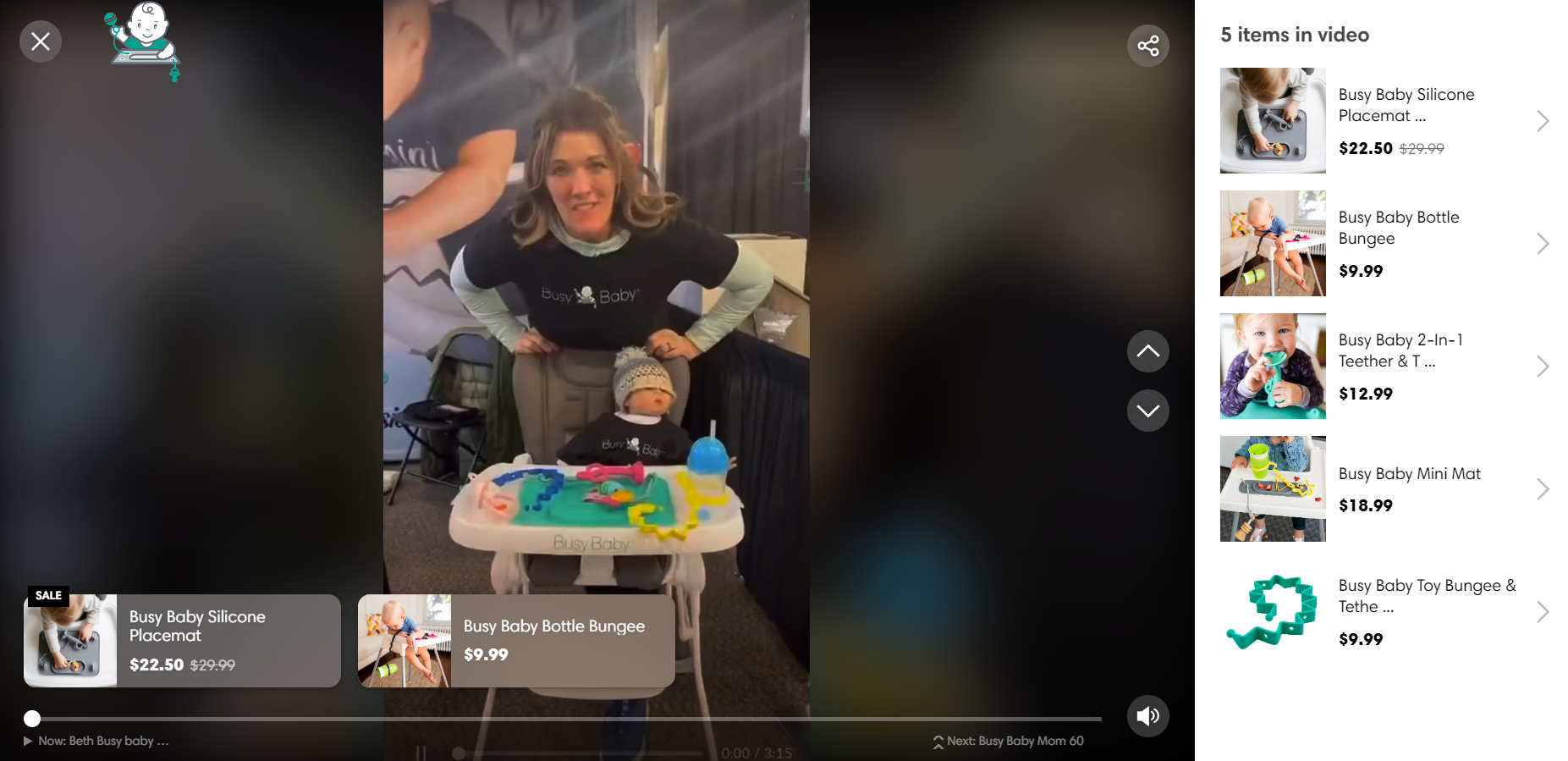
Why it works:
The video shows the product being used by a baby, with proof as to how useful and effective it is. The customer has also added text to explain why they love it, explaining the benefits of the product. By adding these videos on the homepage, the brand can show the value of the product to visitors as soon as they land.
What’s more, Busy Baby Mat has made these videos shoppable. So, instead of clicking out of the video and going to the product page to buy, visitors can add the product to their cart while they are fully engaged and watching the video.
Learn more about the effectiveness of adding shopping videos within your eCommerce store.
8. Once Upon a Farm - Provide value from the community
It's almost impossible for parents to find packaged foods that are healthy and safe for their children. On a mission to change this, Once Upon a Farm creates organic and farm-fresh snacks and meals for babies to big kids.
The brand doesn’t just deliver on its promise of healthy packaged foods but has now fostered a community for parents, from helpful tips on nutritious eating to sharing experiences around feeding and food.
Why it works:
Once Upon a Farm reshared a video made by a mom on how to add more veggies to a child's diet. This is one of the best UGC video examples of how you can provide actionable tips to viewers while subtly showing the value of your product.
Besides such how-to videos, the brand also reshares recipes made using their products as well as children's reactions to their delicious treats. The user-generated video content allows the brand to create a positive rapport with its audience and create a sense of community.
9. Immi Eats - Variety of recipes with the same product
If you're looking for a brand that pays homage to ramen, the answer is Immi Eats. The brand is known for its first low-carb, plant-based, high-protein instant ramen.
But, when selling food items like ramen online, it's hard to do it justice with just a few words and pictures. That's why almost every page on Immi Eats' website has videos that shoppers can dive into. These videos feature customers enjoying the ramen, unique recipes, and reactions.
Why it works:
Besides adding UGC visual elements, Immi Eats got a few things right with the video section on their product page.
-
High engagement and value: Website visitors can watch videos of the ramen being made or eaten right from the product page. They get to see different recipes they can try and learn about the product in an engaging way.
-
Instant checkout: Instead of having to exit the video player to buy, shoppers can add the item to their cart and directly checkout
-
Less likely to drop off: Within the video player, viewers can also view a section recommending other products so that they can keep browsing.
10. Feel Goods - Real stories from real customers on the product’s results
Feel Goods was founded on the remedies that our mothers would whip up when we were unwell. The brand is known for its range of natural blends made for immunity, gut, and daily well-being.
On their product page, Feel Goods has added a section of videos about the product that customers shared on TikTok. These videos range from health tips that recommend the product to recipes to even testimonials.
For food brands, one of the easiest ways to pick up user-generated videos is with recipes. Feel Goods is one of the best UGC video examples of it!
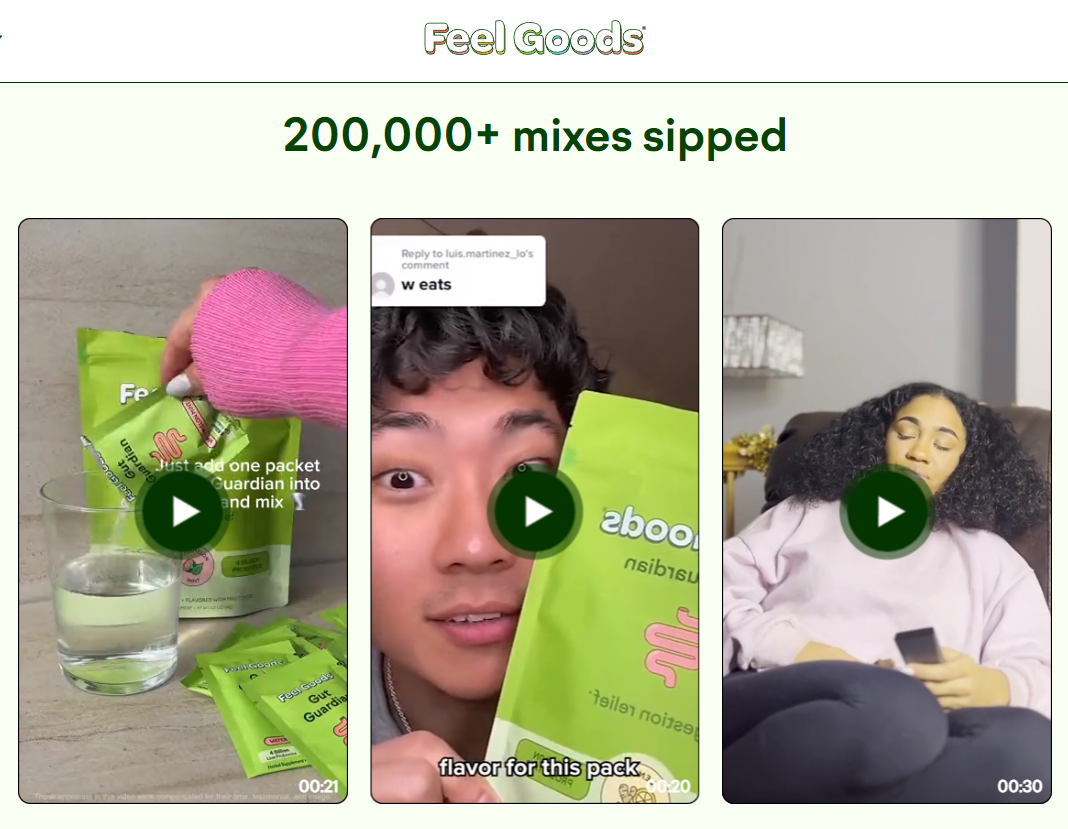 Why it works:
Why it works:
When buying a health product online, shoppers are skeptical since they would be more cautious of what they put in their bodies. So, they need a lot more assurance of its safety and results. With this section on the product page, the brand can convince new shoppers of the product’s credibility and impact through real stories from genuine customers.
Pro-tip: Many eCommerce stores add testimonial videos on their homepage. This way, new visitors can instantly see the value of their products as well as the brand’s credibility, making them more likely to continue browsing the store.
Benefits of using UGC video for eCommerce
User-generated content videos are an essential part of any brand's marketing strategy, with advantages outweighing strategies like influencer marketing. Here’s why every eCommerce brand must leverage UGC videos:
1. Cost-effective
Unlike other forms of marketing like paid ads, influencer marketing, or even affiliate, user-generated content requires little to no investment.
Since customers are eagerly creating videos about the brand and its products themselves, all brands need to do is reshare these videos. This is what makes UGC videos the most cost-effective marketing tactic for brands online.
2. Authentic
Since these videos are created and shared by customers of the products, potential buyers are more likely to trust them than videos created and shared by the business.
With user-generated videos, businesses can put the voices and opinions of past customers in the spotlight, providing an authentic perspective and building better trust among new customers.
3. Builds a community
When customers create and share UGC videos online, businesses have the opportunity to turn them into their brand advocates, letting real customers prove the value of their brand and products. Seeing real customers on the brand's social platform would make potential customers also want to buy and share their experiences with the product.
As more people share their experiences with the brand, their community grows larger, with more interactions among customers and even conversations between the brand and its audience.
User-generated content has the power to help brands build a community organically.
4. Understand customers better
User-generated content doesn't just give you new content to repurpose for your own marketing. It also gives a ton of information on your customers and their preferences.
You can understand how customers like their products, how they use them, what features or aspects they aren't fond of, etc. With these insights, you can identify how to improve your products, what new pain points you can create products for, and even tailor your marketing campaigns and customer experience.
5. Increased engagement
Since user-generated videos aren't promotional, customers are more likely to watch them. By featuring UGC videos on your social media channels, your existing followers would engage with your video content better.
With better engagement, your content can reach new audiences easily.
6. Better conversions
When potential buyers see videos featuring real people, they are more likely to consider your product and click through to browse the product page. By showcasing real customers and their experience of your products, you can provide potential customers with a better understanding of your products, build better trust, and give them the confidence to buy from you.
In fact, having any form of UGC on product pages increases conversion by 8.5%.
UGC videos are a sure way to increase conversions for your eCommerce store.
What types of user-generated videos do consumers share?
User-generated video content fall into different categories based on the type of video being shared.
Here are 8 types of user-generated video content that consumers would usually create and share:
1. Before and after
Many people share a transformation or improvement such as a home renovation project, skin changes, etc. These videos show a comparison of the "before" and "after" states to highlight the progress made over time. These UGC videos are a great way to show viewers the positive effects of your product.
For instance, while talking about skincare products, many consumers share a before-and-after video of using an anti-acne serum, showing how well the product worked on their skin.
2. Product review
Another common type of user-generated video is product review. In these videos, consumers share their thoughts and opinions about a particular product, sharing the features it has, benefits they say, as well as drawbacks of it. Within these videos, the consumer may also share advice on the best way to use the product.
Product reviews are a great way for viewers to compare different products and make an informed purchasing decision.
3. Product usage tips
Many consumers on social media tend to share videos on how to use a product more efficiently. These user-generated videos are especially helpful for customers new to the product.
For instance, consumers passionate about tech create videos sharing hidden features of a new smartphone. Or, a consumer who shares fashion content could show 7 different ways to style one piece of clothing.
With videos on product usage tips, brands have external sources verifying the credibility and effectiveness of their product.
4. Vlogs
Vlogs are one of the first types of user-generated videos that were shared on the internet. In these “video logs,” people share their daily life or experience with their audience.
Through these vlogs, people may talk about or even use products. Since they see the person sharing the video as a reputed personality, viewers would be interested in the product and even go so far as to purchase it themselves.
As a brand, you can pick out snippets from vlogs where your product is featured and reshare them on your social media or embed it within your website to increase credibility.
5. Tutorials
Tutorials teach audiences how to do a specific task or skill, from makeup to cooking to DIY. Tutorials usually involve step-by-step instructions that guide the viewer on how to complete a task, including tips to help the viewer get the best results.
In a tutorial, people are likely to show products they are using to help viewers pick out the right product. For instance, people sharing beauty content may show how to draw the perfect winged liner and even share eyeliners they use that have the right texture for the same.
6. Unboxing
In an unboxing video, people film themselves opening and unpacking a new product, showing viewers how the product is packaged and sharing their first impressions of the product. An unboxing video is a great way for the people to share why they bought the product— problems they hope it would solve and benefits that the product promises
These UGC videos are most popular for tech products, beauty, and fashion items, as well as subscription box services.
Pro-tip: Brands can reshare these unboxing videos especially to hype up new products.
7. Educational
Many people online share educational videos in an attempt to teach their audience about a particular topic or subject. These user-generated videos can be short explainer videos or even longer lesson-type videos.
A consumer sharing beauty content may share videos on specific skincare ingredients, how they work, etc while recommending products.
8. Product Hauls
Product hauls are a type of UGC video content where people showcase their recent purchases, with opinions and thoughts on why they bought the item. These videos are seen to be entertaining for viewers, making it easier for them to get ideas on new products to buy.
Platforms for collecting UGC Video Content
Brands typically collect user-generated video content through popular social media channels. These are the five common ones that brands rely on:
1. Instagram
With more than 1 billion active monthly users, Instagram is one of the most popular social media sites for sharing UGC videos. This is mainly thanks to “Reels” which many people use to share short-form video content.
Brands can encourage audiences to share videos using branded hashtags or even use other engagement formats like Stories. This lets you build a community that will then eagerly share video content without being asked to!
2. TikTok
TikTok has seen massive popularity in the last few years. The social video platform is primarily popular among younger audiences.
What’s unique about picking up user-generated content videos from TikTok is that the social channel has highly niche spaces where customers share videos about specific interests. Due to this, there are more videos being made by customers about brands and products that they love.
3. YouTube
As the pioneer in video content, YouTube is best known for its ability to function as a search engine. Here are 2 ways to use YouTube for user-generated video content:
-
When people on YouTube share UGC about your brand, you can export and repurpose that video on various social media platforms and even your website.
-
As a brand, you can also upload UGC videos to create a library of customer testimonials and videos about your products. This can help your brand rank better on search engines.
When collecting user-generated videos from YouTube, you don’t need to go scour the largest video library online! Instead, you can automatically find and use YouTube videos that mention your brand and your products using Videowise.
As a YouTube Compliant Partner, Videowise makes it easy for your eCommerce brand to find videos made and add them to your website. Learn more about the Find UGC.
4. Facebook
While Facebook's popularity has declined, the platform is still relevant, especially among slightly older audiences. While consumers don't actively share UGC on Facebook, it's always best to keep an eye out.
How to organically get more UGC videos about your brand
People online aren’t just going to create videos featuring your brand and products. Getting consumers to create UGC videos about you is purely about ensuring you’ve built a significant brand presence as well as products worth recommending.
Besides creating and selling value-adding products, here are 5 ways you can encourage consumers to share user-generated video content for your brand:
1. Prioritize customer experience and build loyalty
When customers share products they love, they are also thinking about the experience they had buying the product. Providing a great customer experience— from social media to browsing the website to checkout to receiving the product— is critical in turning shoppers into loyal customers.
When there’s higher brand affinity, these customers would eagerly talk about the product on social media and recommend it to their network.
2. Engage with your audience
Even the small ways of engaging with your audience add up. By responding to comments, creating surveys, and replying to their Instagram Stories about your products, you can slowly build a relationship with your audience. This two-way dialogue will make your audience eager to actively talk about your brand and your products.
3. Use your social media platforms to collect responses
One way to get user-generated content from your audience is by asking for their opinions. Using your social media platform, you can create polls, ask questions related to the industry you sell in, and even ask for feedback.
By doing this, you can pull in new content, building a relationship with your audience. They would then be more eager to share their experiences with your products, even without being asked to.
For instance, a health and wellness brand could ask its followers to share their morning routine. Or when talking about a stress-relief supplement they sell, the brand could ask their followers to share how they manage their stress.
4. Run a campaign encouraging people to share their experience with your brand
Another way to pull more user-generated content is by running a campaign, asking people to share how they use your brand. The campaign could be a contest where consumers with the best response could win a prize. If you aren't open to running a contest, you can just ask your followers to share their experience with your brand for a chance to unlock a discount or be featured on your social media.
Putting your consumers at the center of your marketing is one of the best ways to get more user-generated videos organically.
5. Make it about the mission
When talking about your products on social media or even your website, make your messaging more about the mission and less about the products you sell. With your mission, you can make your audience feel like they are a part of something value-adding, rather than it being about your brand selling more products.
For instance, a skincare brand might have a mission to create scientifically formulated and safe skincare products. They could use this mission to champion transparency and talk more about how their products align with this mission than just about the outcome of the products.
Best practices when sharing UGC videos
When sharing user-generated videos on your social media channels or even on your website, you need to keep these best practices in mind:
1. Ask for permission before resharing
Before resharing user-generated content video, always ask the customer for permission. You can send them a message or comment on the video asking if you can reshare it. Getting permission helps you avoid copyright infringement.
2. Credit the customer when resharing
When sharing the UGC video on social media, credit the customer who shared the video by tagging them within the post or mentioning credits in the caption. By giving credit to them, you show that you value the customer’s efforts and give them the deserved highlight.
Pro-tip: Use the caption to appreciate the person like pointing out how uniquely they've used the product.
3. Add a caption that highlights more about your product
Besides crediting the customer, you can use the caption to share more about the product used in the video, talking about its features and benefits. This additional context can help viewers understand your product better and even convince them to learn more about it.
Don’t forget to also name the product within the caption so that shoppers can easily find it in your store.
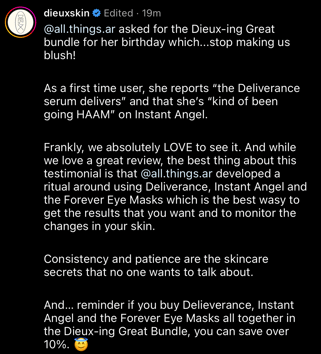
4. Reply back to comments made on the post
Once you've shared the video, actively engage with the comments, replying to your audience. By engaging with your viewers, you build a better rapport with your audience and make your followers eager to continue engaging with your posts. This way, you can organically build a community.
5. Embed these user-generated videos within your eCommerce store
Besides sharing them as social media posts, we highlight recommend that you host user-generated content videos on your website. New visitors browsing your store will be able to see stories of real customers and their experience with your product.
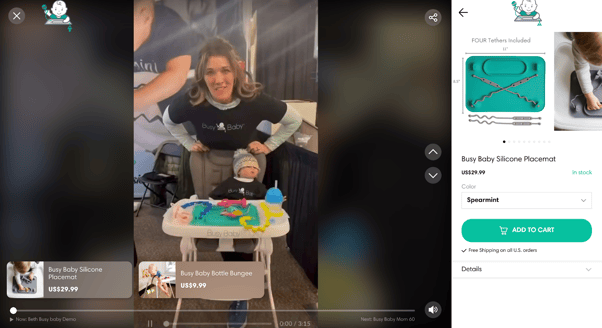
This will help them gain more trust in your brand, get an unbiased opinion about your products, and give them all the information they need to decide to buy.
“Another great way to leverage UGC is to put all the lights on it! By that, I mean that D2C brands should integrate user-generated videos on their product pages to provide social proof and help customers make purchase decisions. This can also help to increase time spent on the site and reduce bounce rates” - Mihaela Tudorache, Product Manager at Videowise
Add UGC videos onto your eCommerce store with Videowise. The platform lets you import UGC videos from various social media sites and add them to any page on your site.
Book a demo and see how Videowise works!
6. Leverage UGC videos within your email campaigns
UGC videos can also help you improve conversions for your email campaigns. Instead of driving the CTAs on your emails to your website, you can take subscribers to a landing page where you’ve embedded user-generated videos. This keeps your subscribers better engaged, and the videos let you educate them about the product. Once convinced to buy, subscribers can check out right through the video.
Platforms like Videowise let you create dedicated pages with an embedded video player so that you can deliver an immersive shopping experience through your UGC videos. Once they watch the video, shoppers can instantly add the item to cart and checkout, with no interruptions needed.
Frequently Asked Questions
1. What are some common mistakes to avoid when using UGC video for eCommerce?
When sharing user-generated videos, there are a few common mistakes that businesses make:
-
Not getting consent from the customer
Before sharing the UGC video, get permission from the customer who shared it. By not asking for permission to reshare, the content could be at risk of being pulled down and worse, you may end up violating copyright laws.
-
Not acknowledging the customer
When resharing user-generated videos, you must make sure that you thank the customer for sharing and even providing your input, like commenting on their unique use of your product.
-
Not integrating UGC videos on your website
User-generated videos shouldn't just exist on your social media channels. Your website is the most important touchpoint for your brand, helping you turn visitors into customers. Adding UGC videos to different parts of your website is the most engaging way to educate shoppers about your products and drive purchases through these videos
2. How can eCommerce merchants repurpose UGC video content for different marketing channels?
Online businesses can leverage UGC video content at different touchpoints of their brand in different ways:
-
Social media: Reshare the user-generated video on various social media platforms like Instagram or TikTok to help new audiences discover your brand.
-
Website: You can add UGC videos to different parts of your website to increase trust, give more information about your products, and increase conversions. Adding user-generated videos on the homepage and product pages can significantly boost sales.
For additional methods to increase sales, take a look at our curated list of Best eCommerce apps. -
Email marketing: Instead of taking customers to your website, you can create a landing page featuring UGC videos so that subscribers engage with your brand better and learn more about your products in an immersive manner.
-
Advertising: Instead of creating a polished video for your paid ads, amplify user-generated video content. This way, your ad will seem more authentic, and audiences will be more likely to engage and click through to browse your products.
3. What types of UGC videos convert best for eCommerce?
The highest-converting UGC videos for eCommerce include:
-
Try-on and fit videos: Fashion and beauty brands see the best results with customers showing how products look and fit on real bodies
-
Before/after transformation videos: Particularly effective for beauty, skincare, and wellness products, showing actual results
-
Product demonstration videos: Customers showing how they use products in their daily routines or specific use cases
-
Unboxing and first impression videos: Build excitement and show authentic reactions to product packaging and quality
-
Tutorial and how-to videos: Customers explaining creative ways to use products or styling tips
According to industry data, UGC videos on product pages increase conversion rates by 8.5%, with interactive UGC videos seeing conversion increases as high as 100.6%.
4. How do I get customers to create video content about my products?
Here are proven strategies to encourage customer video creation:
-
Post-purchase follow-up: Send emails 7-14 days after delivery asking customers to share their experience via video
-
Incentive programs: Offer discounts, store credit, or exclusive products in exchange for video testimonials
-
Hashtag campaigns: Create branded hashtags and encourage customers to use them when posting videos on social media
-
Make it easy: Provide clear instructions, suggested video topics, and optimal video specifications
-
Feature customer videos: Regularly reshare customer content on your social media and website to encourage more submissions
-
Contests and challenges: Run video contests with prizes to motivate participation
-
Build community: Engage with customers who post about your brand to foster ongoing relationships
5. How can I measure the ROI of UGC video campaigns?
Track these key metrics to measure UGC video ROI:
-
Conversion Rate: Compare conversion rates on pages with UGC videos vs. without (expect 8.5%+ increase)
-
Time on Site: UGC videos typically increase time on site by 4X
-
Cost Per Acquisition: Calculate the cost of incentives divided by new customers acquired
-
Social Media Engagement: Track likes, shares, comments, and reach on UGC posts
-
Attribution Tracking: Use UTM parameters and tracking pixels to monitor traffic from UGC sources
-
Customer Lifetime Value: Measure if customers acquired through UGC have higher retention rates
-
Content Creation Savings: Calculate savings compared to professional video production costs
-
Brand Mention Volume: Track increase in organic brand mentions and hashtag usage
Use tools like Google Analytics, social media insights, and eCommerce platform analytics to track these metrics consistently.
6. What legal considerations should I know about using customer videos?
Essential legal requirements for using UGC videos:
-
Obtain Written Consent: Always get explicit permission before using customer videos for marketing purposes
-
Rights and Permissions: Secure rights to use, modify, and distribute the content across all marketing channels
-
Music and Audio Rights: Ensure any background music or audio in UGC videos doesn't violate copyright laws
-
Privacy Considerations: Be mindful of privacy laws, especially when featuring minors or personal information
-
Attribution Requirements: Credit the original creator when resharing their content
-
Platform Terms of Service: Understand the terms of platforms where you're sourcing UGC (Instagram, TikTok, etc.)
-
Clear Usage Guidelines: Establish clear terms in your UGC campaigns about how content will be used
-
Content Moderation: Implement processes to review UGC before publication to ensure brand alignment
-
International Considerations: Be aware of varying privacy and consent laws in different regions (GDPR, CCPA, etc.)
Consider working with legal counsel to create proper consent forms and usage agreements for your UGC campaigns.
Increase engagement and conversions with UGC videos!
With user-generated video content, brands can increase trust, engage audiences, and convert shoppers better with an authentic and cost-effective marketing strategy.
Adding UGC videos to your eCommerce store, especially, is crucial since it's one of the main touchpoints where customers are evaluating the product to buy. Adding user-generated video to your online store is easy, with Videowise.
Using the eCommerce shoppable video platform, you can import UGC videos from social media channels like TikTok and Instagram, add these videos to different parts of your store's pages, and make the videos shoppable so that visitors can add them to your cart instantly.
Get started with Videowise now!
Share

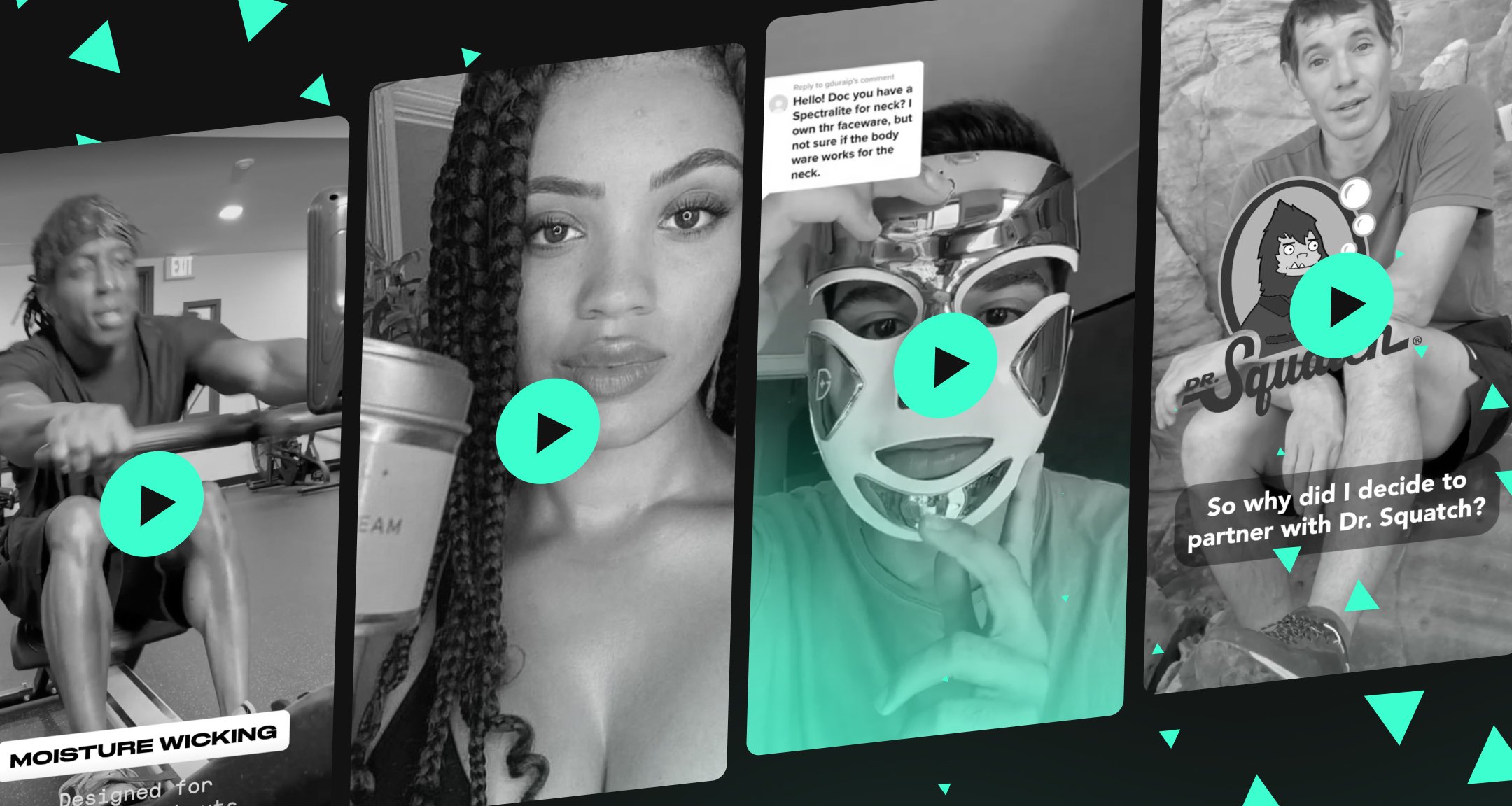
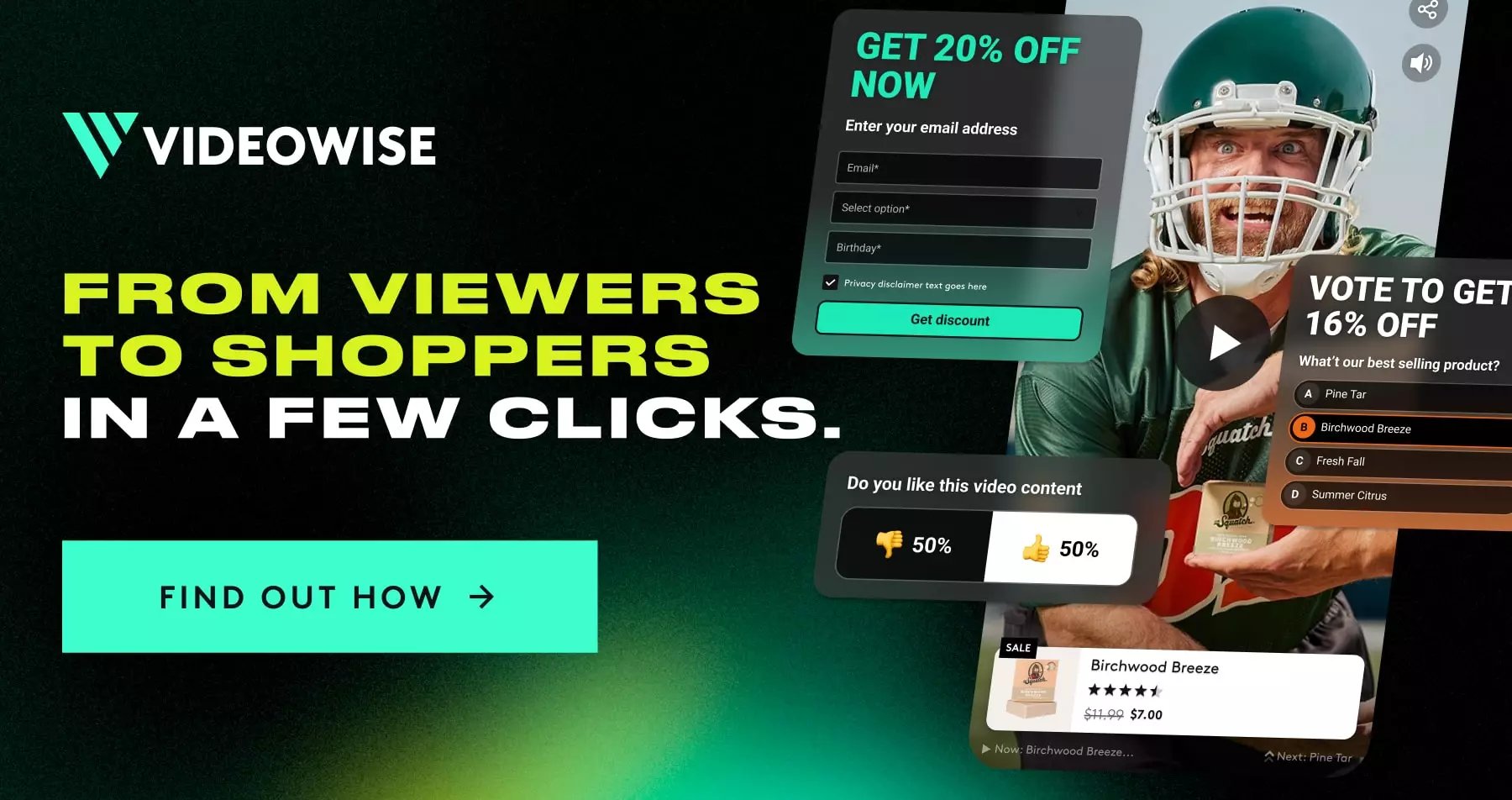


.jpg?width=420&height=420&name=live%20shopping%20top%205%20fashion%20(1).jpg)